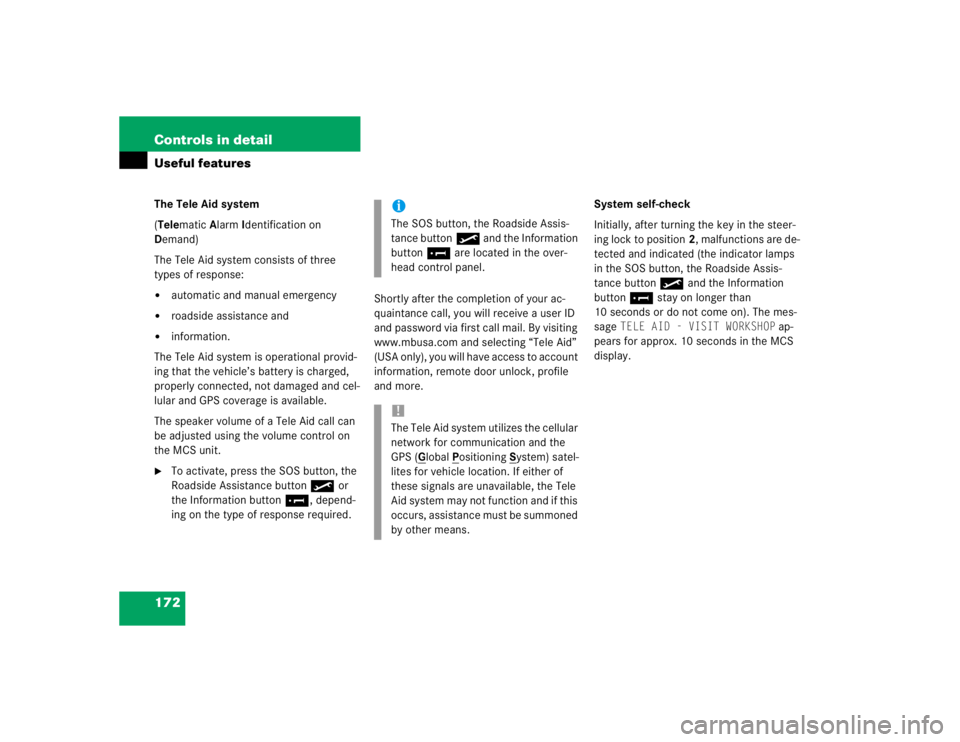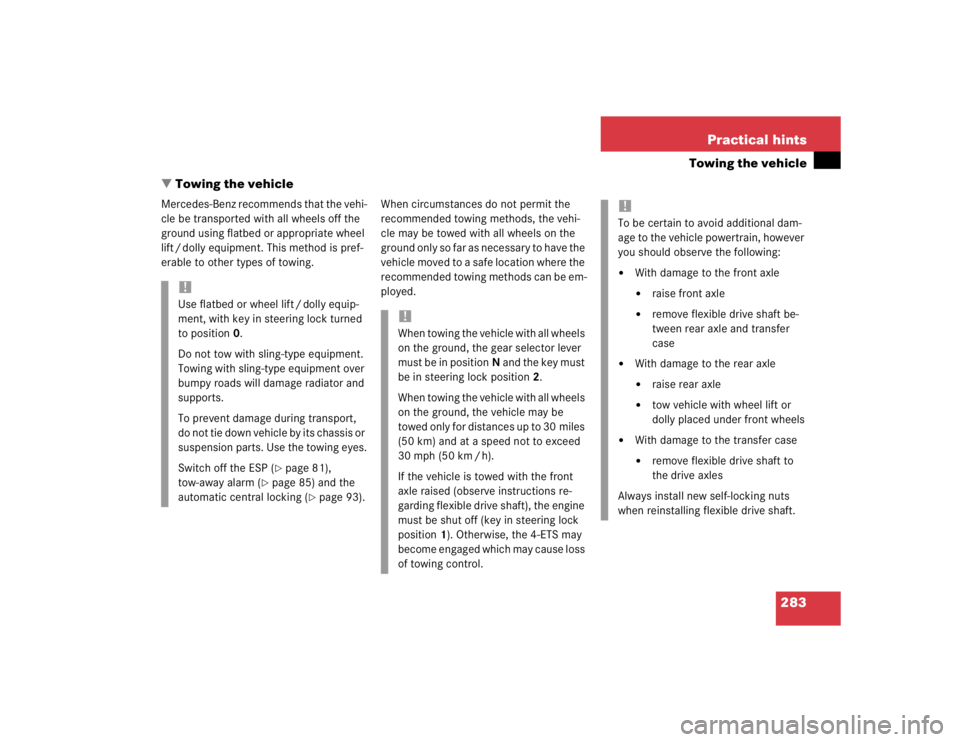Page 895 of 4133
91 Controls in detail
Locking and unlocking
Opening the liftgate
Opening the liftgate from outside
A minimum height clearance of 7 ft
(2.15 m) is required to open the liftgate.
The handle is located above the rear
license plate recess.
1Grip molding
2Handle�
Pull on handle2.
�
Swing the liftgate upward by using the
grip molding.Opening the liftgate from inside
A minimum height clearance of 7 ft
(2.15 m) is required to open the liftgate.
The release lever is located on the inside of
the liftgate.
1Handle
2Catch
iIf the vehicle has previously been
locked from the outside with the re-
mote control, opening a door from the
inside will trigger the alarm.
To cancel the alarm, do one of the
following:
Switch on the ignition by turning the
key in the steering lock to position2.
or
Press the‹ or Œbutton on the
remote control.
The alarm is cancelled.
!Always make sure that there is suffi-
cient overhead clearance.iThe vehicle must be unlocked.
Page 976 of 4133

172 Controls in detailUseful featuresThe Tele Aid system
(Telematic Alarm Identification on
Demand)
The Tele Aid system consists of three
types of response:�
automatic and manual emergency
�
roadside assistance and
�
information.
The Tele Aid system is operational provid-
ing that the vehicle’s battery is charged,
properly connected, not damaged and cel-
lular and GPS coverage is available.
The speaker volume of a Tele Aid call can
be adjusted using the volume control on
the MCS unit.
�
To activate, press the SOS button, the
Roadside Assistance button• or
the Information button¡, depend-
ing on the type of response required.Shortly after the completion of your ac-
quaintance call, you will receive a user ID
and password via first call mail. By visiting
www.mbusa.com and selecting “Tele Aid”
(USA only), you will have access to account
information, remote door unlock, profile
and more.System self-check
Initially, after turning the key in the steer-
ing lock to position2, malfunctions are de-
tected and indicated (the indicator lamps
in the SOS button, the Roadside Assis-
tance button• and the Information
button¡ stay on longer than
10 seconds or do not come on). The mes-
sage
TELE AID - VISIT WORKSHOP
ap-
pears for approx. 10 seconds in the MCS
display.
iThe SOS button, the Roadside Assis-
tance button• and the Information
button¡ are located in the over-
head control panel.!The Tele Aid system utilizes the cellular
network for communication and the
GPS (G
lobal P
ositioning S
ystem) satel-
lites for vehicle location. If either of
these signals are unavailable, the Tele
Aid system may not function and if this
occurs, assistance must be summoned
by other means.
Page 977 of 4133

173 Controls in detail
Useful features
Emergency calls
An emergency call is initiated automatical-
ly:�
following an accident in which the
emergency tensioning detractors
(ETDs) or airbags deploy,
�
if the anti-theft alarm or the tow-away
alarm stays on for more than
20 seconds. See anti-theft alarm sys-
tem (
�page 83) and tow-away alarm
(
�page 84).
An emergency call can also be initiated
manually by opening the cover next to the
inside rear view mirror labeled SOS, then
briefly pressing the button located under
the cover. See below for instructions on
initiating an emergency call manually.
Warning!
G
The Tele Aid control unit is located under
the front passenger seat. If there is accumu-
lation of water or other liquid in this area,
the Tele Aid control unit could suffer an
electrical short circuit making the system in-
operative. In this case the indicator lamp in
the SOS button will not illuminate during or
will remain illuminated after the system
self-check. Have the system checked at the
nearest Mercedes-Benz Light Truck Center
as soon as possible.
If the indicator lamps in the SOS button, in
the Roadside Assistance button and / or in
the Information button do not come on dur-
ing the system self-check or if any of these
indicators remain illuminated constantly in
red and / or the message
TELE AID -
VISIT WORKSHOP
is displayed in the MCS
display after the system self-check, a mal-
function in the system has been detected.
If a malfunction is indicated as outlined
above, the system may not operate as ex-
pected. Have the system checked at the
nearest Mercedes-Benz Light Truck Center
as soon as possible.
Page 1065 of 4133
261 Practical hints
Unlocking / locking in an emergency
�Unlocking / locking in an emergency
Unlocking the vehicle
Unlocking the driver’s door
If you are unable to unlock the driver’s
door using the remote control, open the
door using the key.
1Release button�
Press release button1 on the remote
control.
The key folds out.2Unlocking
3Locking
�
Remove the protective cap from the
door lock.
�
Unlock the door with the mechanical
key. To do so, push the mechanical key
in the lock until it stops and turn it to
the left.
iUnlocking and opening the driver’s
door with the mechanical key will trig-
ger the anti-theft alarm system. To can-
cel the alarm, do one of the following:�
Press buttonŒ or‹ on the
remote control.
�
Insert the key in the steering lock.
Page 1087 of 4133

283 Practical hints
Towing the vehicle
�Towing the vehicle
Mercedes-Benz recommends that the vehi-
cle be transported with all wheels off the
ground using flatbed or appropriate wheel
lift / dolly equipment. This method is pref-
erable to other types of towing.When circumstances do not permit the
recommended towing methods, the vehi-
cle may be towed with all wheels on the
ground only so far as necessary to have the
vehicle moved to a safe location where the
recommended towing methods can be em-
ployed.
!Use flatbed or wheel lift / dolly equip-
ment, with key in steering lock turned
to position0.
Do not tow with sling-type equipment.
Towing with sling-type equipment over
bumpy roads will damage radiator and
supports.
To prevent damage during transport,
do not tie down vehicle by its chassis or
suspension parts. Use the towing eyes.
Switch off the ESP (
�page 81),
tow-away alarm (
�page 85) and the
automatic central locking (
�page 93).
!When towing the vehicle with all wheels
on the ground, the gear selector lever
must be in positionN and the key must
be in steering lock position2.
When towing the vehicle with all wheels
on the ground, the vehicle may be
towed only for distances up to 30 miles
(50 km) and at a speed not to exceed
30 mph (50 km / h).
If the vehicle is towed with the front
axle raised (observe instructions re-
garding flexible drive shaft), the engine
must be shut off (key in steering lock
position1). Otherwise, the 4-ETS may
become engaged which may cause loss
of towing control.
!To be certain to avoid additional dam-
age to the vehicle powertrain, however
you should observe the following:�
With damage to the front axle�
raise front axle
�
remove flexible drive shaft be-
tween rear axle and transfer
case
�
With damage to the rear axle�
raise rear axle
�
tow vehicle with wheel lift or
dolly placed under front wheels
�
With damage to the transfer case�
remove flexible drive shaft to
the drive axles
Always install new self-locking nuts
when reinstalling flexible drive shaft.
Page 1121 of 4133

317 Index
A
ABS 25, 76, 311
ABS control 76
LOW RANGE mode 77
Malfunction indicator lamp 242
Warning lamp 242
Accelerator position, automatic
transmission 123
Accident
In case of 52
Activating
Air circulation mode 139
Air recirculation mode 139
Anti-theft alarm system 83
Automatic climate control 135
ESP 82
Exterior headlamps 48
Hazard warning flasher 112
Headlamps 48
High beams 110
Ignition 33Immobilizer 54, 83
Rear passenger compartment ventila-
tion and climate control 141
Rear window defroster 133
Rear window wiper 51
Residual heat 140
Seat heater* 98
Tow-away alarm 85
Warning indicators (Parktronic*) 155
Windshield wipers 50
Activating automatic central locking 93
Adding
Coolant 223
Engine oil 221
Additional turn signals 266
Adjustable steering column
Indicator lamp 253
Adjusting 34
Backrest tilt 36, 38
Exterior rear view mirror 40
Head restraint height 36, 38Head restraint tilt 37, 39
Headlamp aim 272
Instrument cluster illumination 116
Manual seat 35
Mirrors 40
Power seats* 37
Seat cushion tilt 38
Seat fore and aft 35
Seat fore and aft adjustment 37
Seat height 36, 38
Seats 34
Steering wheel 39
Adjusting air distribution
Automatic climate control 137
Adjusting air volume
Automatic climate control 137
Air conditioner (cooling)
Turning on 139
Air conditioning
Cooling 139
Page 1122 of 4133

318 IndexAir conditioning refrigerant 302
Air outlets
Automatic climate control 142
Air pressure see Tire inflation
pressure 227
Air recirculation mode 138
Activating 139
Deactivating 139
AIRBAG OFF
Warning lamp 243
Airbags 59
BabySmart
TM airbag deactivation
system 311
BabySmartTM deactivation
system 70
Children 60
Front 63
Passenger 63
Safety guidelines 62
Side impact 64
Window curtain 64Alarm
Audible 75, 84, 86
Canceling 84, 86
Visual 83
Alarm system
Anti-theft 83
Anticorrosion/antifreeze 305
Antiglare
Automatic 126
Antilock brake system (ABS) 311
Anti-theft alarm system
Arming 83
Canceling alarm 84, 86
Disarming 84
Anti-theft systems
Anti-theft alarm system 83
Immobilizer 83
Tow-away alarm, glass breakage
sensor 84
Aquaplaning see Hydroplaning 197
Armrest
Storage compartment in front of 165
Storage spaces 165Armrest in rear seat bench 167
Ashtray
Front center console 168
Rear center console 169
ATF (automatic transmission fluid) 222
Attaching a trailer 208
Automatic antiglare for rear view
mirror 126
Automatic central locking
Activating 93
Deactivating 93
Automatic climate control 134
Adjusting air distribution 137
Adjusting air volume 137
Air conditioning 139
Air outlets 142
Air recirculation mode 138
Basic setting 137
Changing basic setting 137
Defrosting 138
Economy mode 135
Page 1126 of 4133

322 IndexCoolant 222, 304
Adding 223
Anticorrosion/antifreeze
quantity 304
Checking level 222
Indicator lamp 249
Temperature 213
Temperature gauge 117
Coolant level
Checking 215, 222
Crossing obstacles 204
Cruise control 150, 311
Canceling 151
Driving downhill 151
Driving uphill 151
Fine adjustment 152
LOW RANGE mode 152
Saving current speed 151
Setting speeds 152
Cruise control lever 150Cup holder 166
Cleaning 238
In front seat armrest 167
In instrument panel 166
In rear centerconsole 167
Customer Assistance Center (CAC) 311
D
Daytime running lamp mode 109
Deactivating
Air conditioning (cooling) 139
Air recirculation mode 139
Alarm 84
Anti-theft alarm system 84
Automatic climate control 135, 137
Cruise control 151
Defrost 138
Engine 54
ESP 81
Front fog lamps, rear fog lamp 111
Hazard warning flasher 112
Headlamps 54
Immobilizer 83
Rear passenger compartment ventila-
tion and climate control 141
Rear window defroster 133Residual heat 140
Seat heater* 98
Tow-away alarm 85
Tow-away alarm (vehicles with trip
computer*) 85
Tow-away alarm (vehicles without trip
computer*) 86
Deactivating automatic central
locking 93
Deep water see Standing water 200
Defogging
Windshield 138
Defrosting 138
Difficulties
While driving see Problems while
driving 51
With starting 47
Direction of rotation (tires) 227
Discharged battery
Jump starting 281
Disconnecting
Vehicle battery 279
Display in the speedometer 117